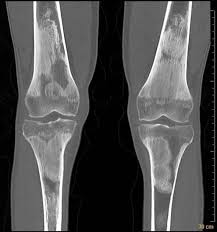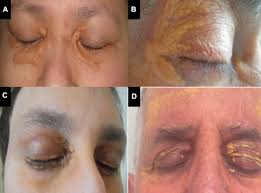

Erdheim-Chester disease (ECD) is a rare non-Langerhans cell histiocytosis characterized by the infiltration of tissues by foamy histiocytes.
It’s a histiocytic neoplasm.
Reported incidence of 0.35 per 1 million adults.
Onset typically is in middle age, although younger patients have been documented.
It is a disease involves an infiltration of lipid-laden macrophages, multinucleated giant cells, an inflammatory infiltrate of lymphocytes and histiocytes in the bone marrow, and a generalized sclerosis of the long bones.
It is characterized by variants in the mitogen activated protein kinenase (MAPK) pathway, most frequently BRAF V600 E (50%).
Long bone involvement is almost universal in ECD patients and is bilateral and symmetrical in nature.
More than 50% of cases have extraskeletal involvement: kidney, skin, brain and lung involvement, and less frequently retroorbital tissue, pituitary gland and heart involvement is observed.
Typically involves the perirenal spaces leading to the appearance of hairy kidneys in 50 to 60% of cases.
Sclerotic bone lesions are present in 95% of cases, classically seen in the metaphysis of the femurs bilaterally.
Bone pain is the most frequent of all symptoms associated with ECD.
Bone pain mainly affects the lower limbs, knees and ankles.
The pain is often mild but persistent, and juxtaarticular in nature.
Exophthalmos occurs in some patients and is usually bilateral, symmetric and painless.
Exophthalmos in most cases occurs several years before the final diagnosis of ECD.
Recurrent pericardial effusion can occur.
Morphological changes in adrenal size and infiltration may be seen.
Symptoms in order of frequency of occurrence:
Bone pain Retroperitoneal fibrosis Diabetes insipidus Exophthalmos Xanthomas Neurological and central nervous system involvement Dyspnea caused by interlobular septal and pleural thickening Kidney failure Hypopituitarism Liver failure
Diagnosis is made by radiologic findings of osteosclerosis and histologic features.
Diagnosis can often be difficult because of the rareness of ECD as well as the need to differentiate it from LCH. A diagnosis from neurological imaging may not be definitive.
The presence of symmetrical cerebellar and pontine signal changes on T2-weighted images seem to be typical of ECD, but, multiple sclerosis and metabolic diseases must be considered.
Thoracoscopic surgery may be used for diagnostic confirmation and also for therapeutic relief of recurrent pericardial fluid drainage.
Histologically, ECD differs from Langerhans cell histiocytosis (LCH): it does not stain positive for S-100 proteins or Group 1 CD1a glycoproteins, and electron microscopy of cell cytoplasm does not disclose Birbeck granules.
Tissue biopsies show xanthomatous or xanthogranulomatous infiltration by lipid-laden or foamy histiocytes, and are usually surrounded by fibrosis.
Bone biopsy has the greatest likelihood for a diagnosis.
Approximately half of patients harbor point mutations of the BRAF gene at codon 600 substituting the amino acid glutamine for valine.
Biopsy shows histiocyte proliferation.
There is an overlap of ECD or mixed hisstiocytosis and myeloid, and myeloproliferative malignancies have been described in approximately 10% of cases.
Treatment
Vemurafenib targets the BRAF protein.
Cobimetinib, an oral inhibitor of MEK1 and MEK2.
Other treatment options include:
Interferon-α High-dose corticosteroid therapy Chemotherapy Radiation therapy Surgical debulking Ciclosporin
Erdheim–Chester disease was previously associated with a high mortality rate.
However, long-term survival is now improved.
Targeted therapies using BRAF, MEK and/or other inhibitors have been dramatically efficacious.
ECD affects predominantly adults, with a mean age of 53 years.
Interferon-α: Historically, interferon-α has been the first-line treatment for ECD, demonstrating efficacy in improving overall survival.
For patients with the BRAFV600E mutation, BRAF inhibitors such as vemurafenib and dabrafenib have shown dramatic efficacy.
BRAF inhibitors target the MAPK pathway, which is activated in a majority of ECD cases
MEK Inhibitors: In cases where BRAF mutations are absent but other MAPK pathway mutations are present, have been effective.
Immunomodulatory and Anti-cytokine Therapies: anakinra (IL-1 receptor antagonist) and infliximab (TNF-α inhibitor) have been used with success, particularly in patients who do not respond to interferon-α
Cladribine a purine analog has been used in refractory cases, showing some efficacy in reducing disease burden.
Recent advancements include the identification of the BRAFV600E mutation and other MAPK pathway mutations, which has led to the use of targeted therapies as a cornerstone of ECD management.
The efficacy of BRAF and MEK inhibitors have high rates of radiologic and clinical responses.
